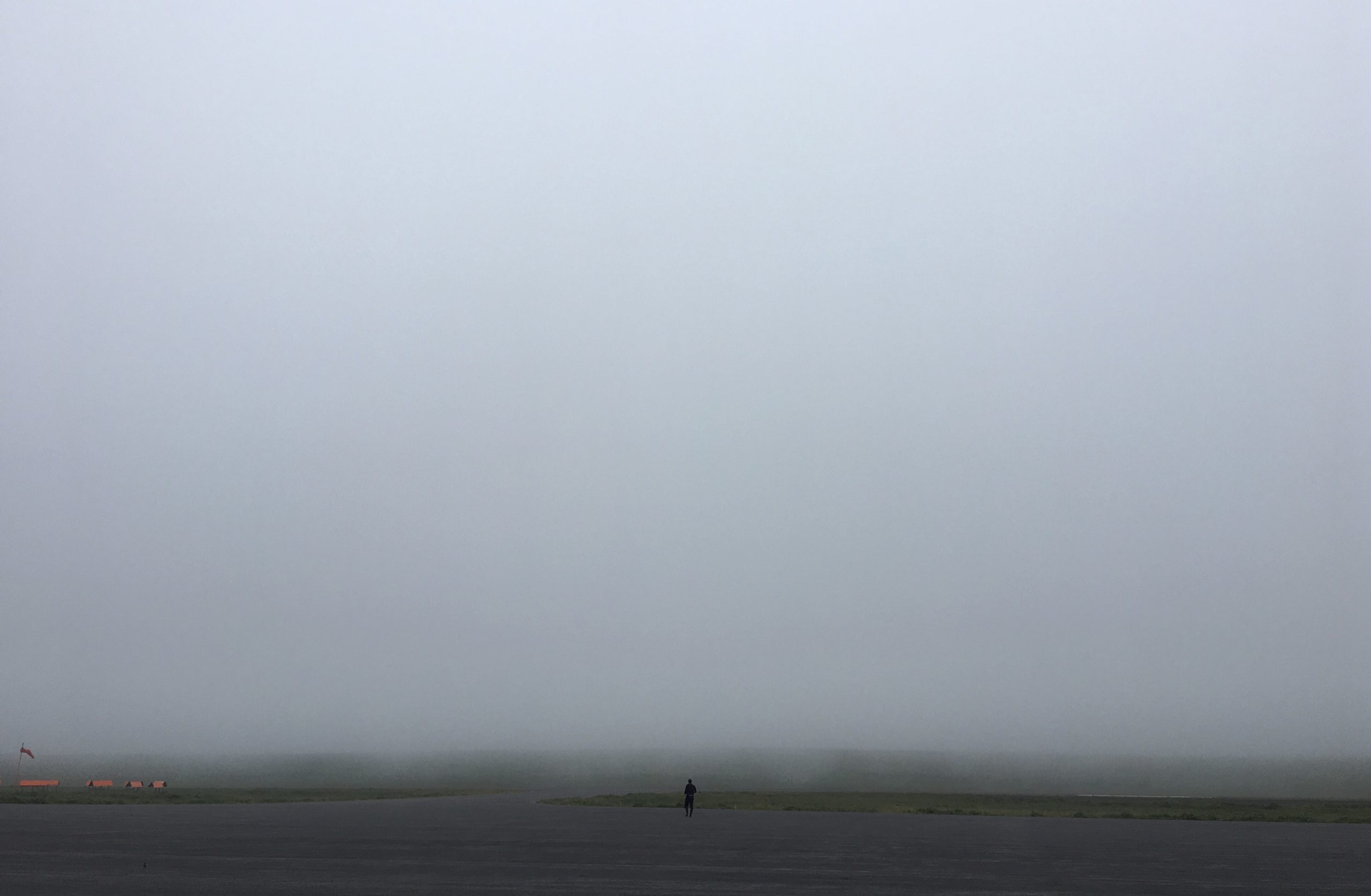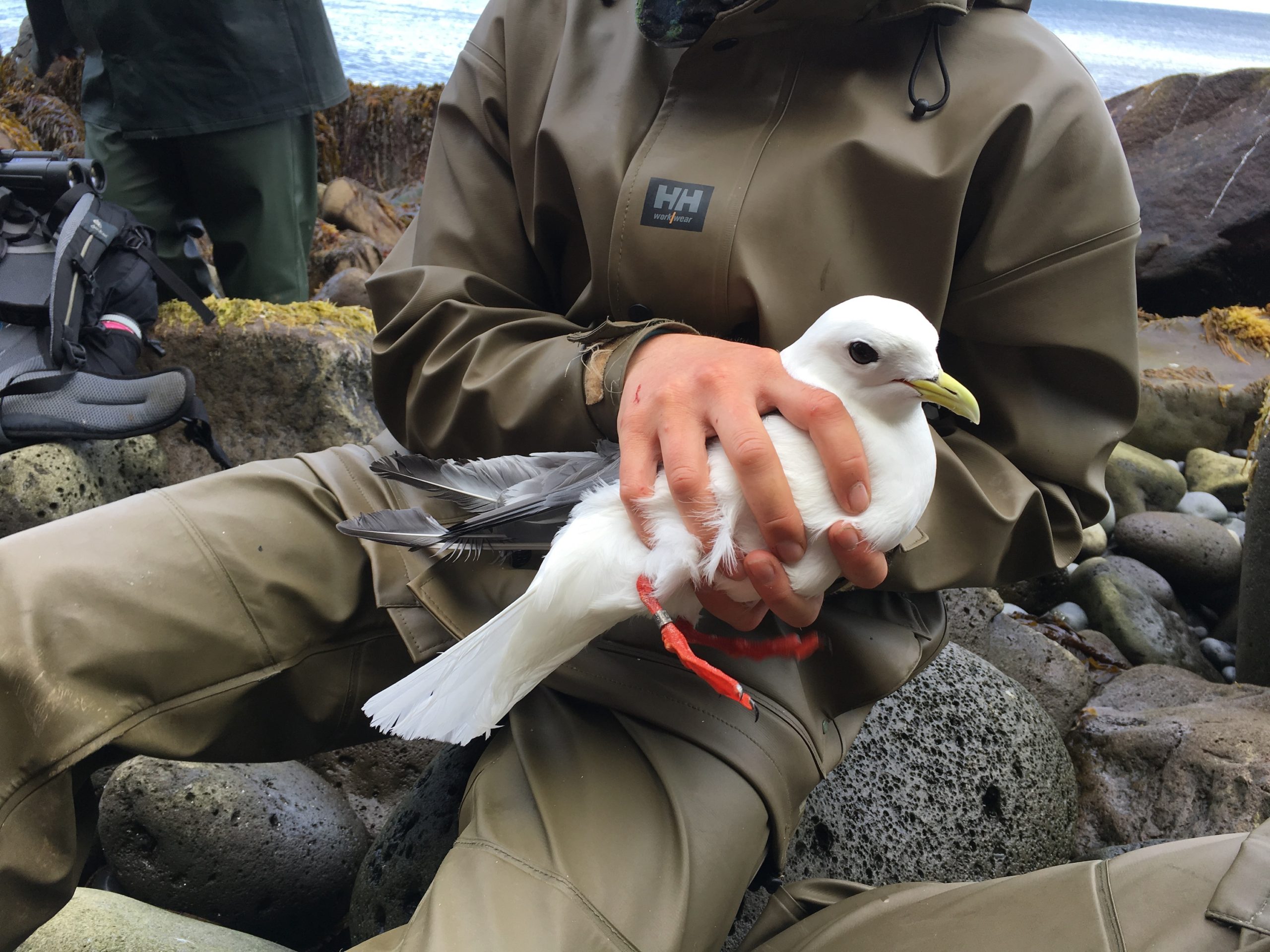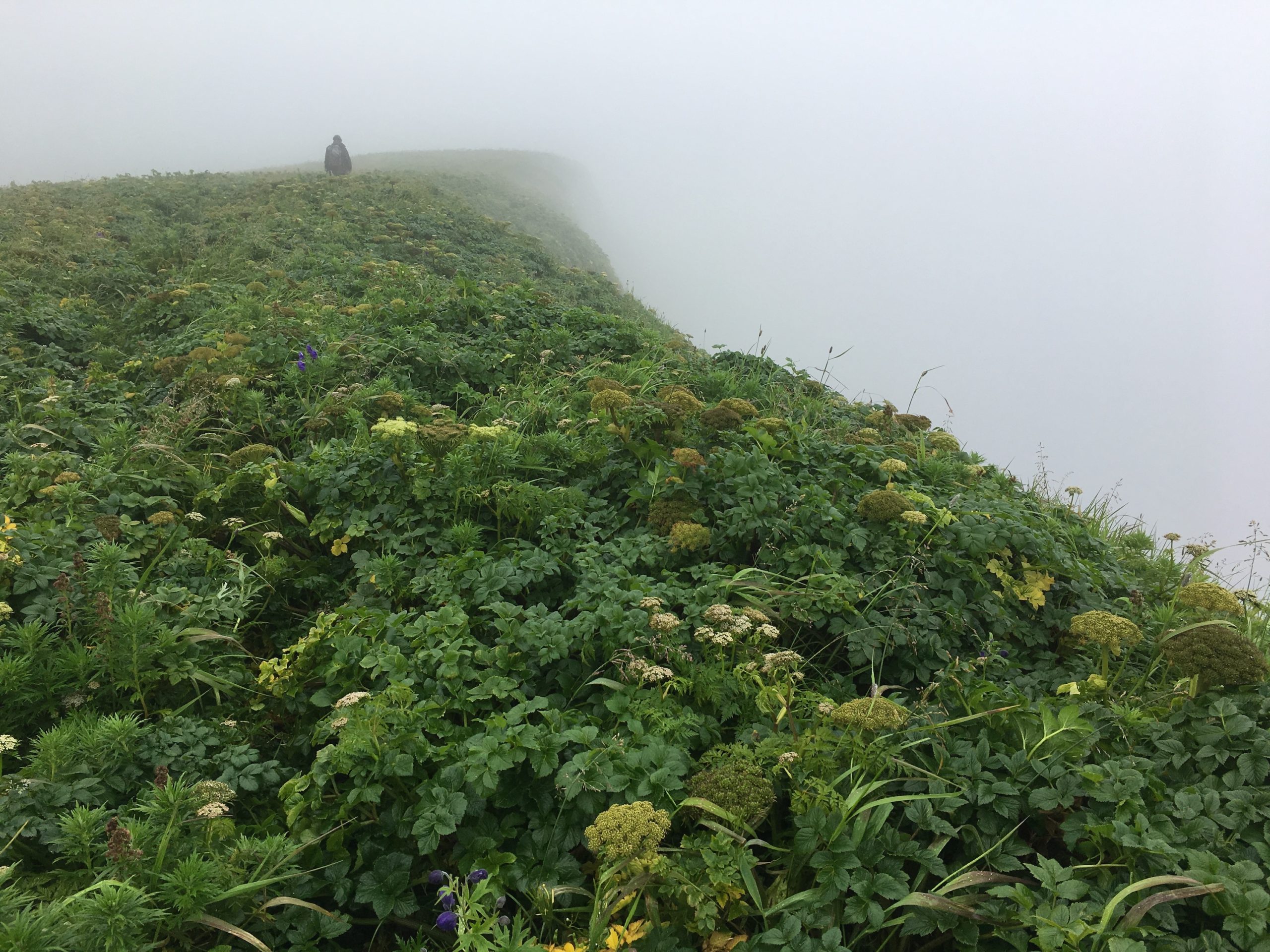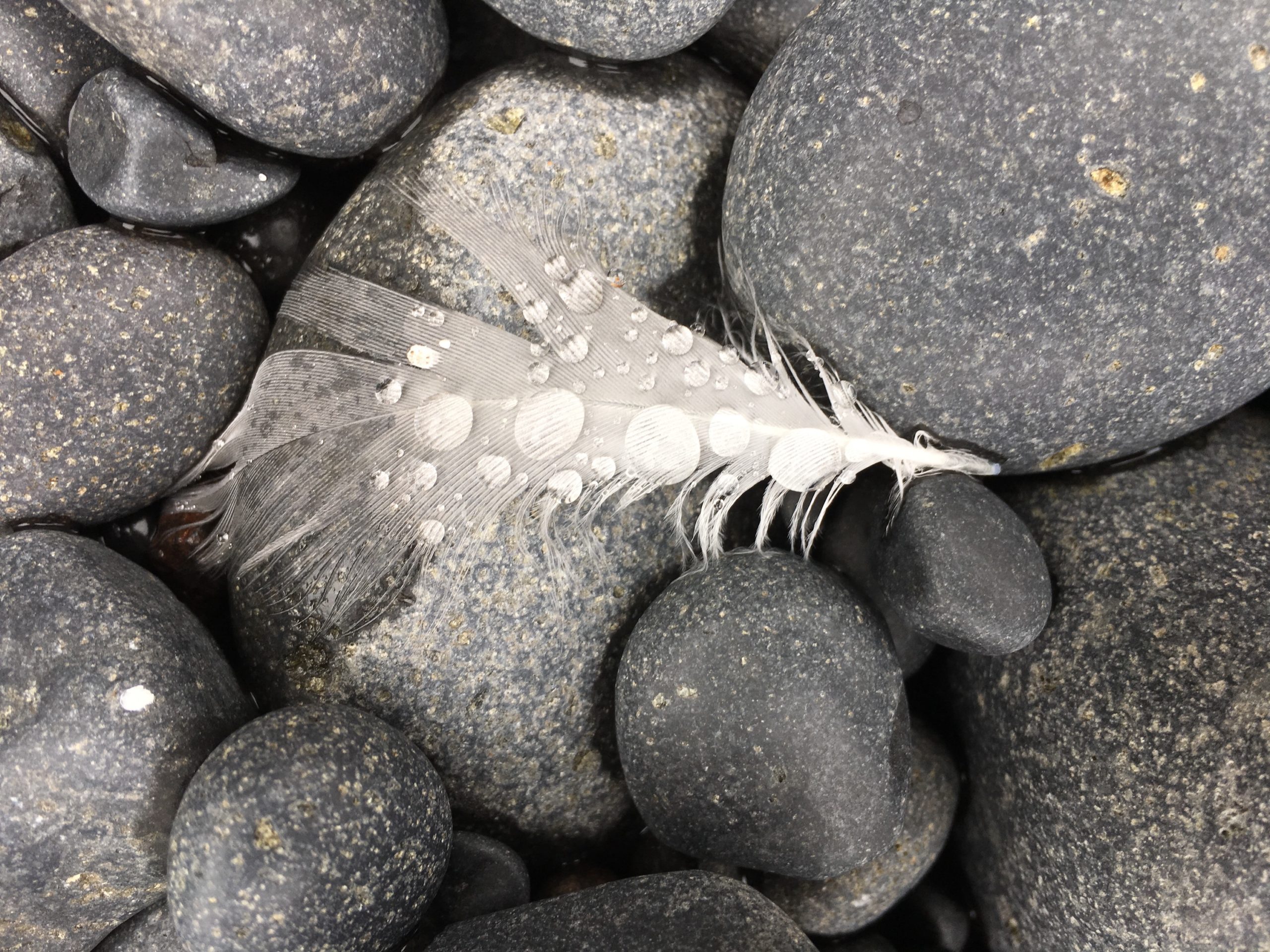
fog \’fog, fäg\ n : vapor condensed to fine particles of water suspended in the lower atmosphere that differs from cloud only in being near the ground ; a state of bewilderment ; something that confuses or obscures
suspend \ sə-‘spend \ vb 1 : to keep fixed or lost (as in wonder or contemplation) b : to keep waiting in suspense or indecision
“Good luck getting off the island,” they said, as we stepped from the Zodiac.
They stood at the top of the boat ramp, three teenage boys slouched deep into their sweatshirts amid the rain-greased rocks, their faces shadowy in their hoods. Behind them, the tiny Unangan town of St. George, Alaska leaned into the emerald green slope, crowned with the matching emerald green roof of a Russian Orthodox church. Nathaniel and I looked back at the ship we had just left. It was the kind of day where low clouds press you into the earth like a heavy thing balanced on your head. But the fur seals rolling amid the kelp near the shore of St. George Island were glossy and light with play.
It was August 2019, and we were on the last leg of a two-week reporting trip, shadowing a U.S. Fish and Wildlife Service research expedition to the Bering Sea island of St. Matthew. We had debarked on St. George on the way back south, so we could spend two days with the field crew monitoring the millions of seabirds that nest on the island’s towering cliffs. Then we’d hop a plane to Dutch Harbor, and from there, Anchorage—Nathaniel to visit his wife and baby daughter before another photo assignment, and me to go home to Washington.
The following day was enough to reassure us, exhausted as we were from our journey, that this plan was a solid one. It came blustery but sunny, with the Bering Sea clear and calm as a swimming pool. I followed two dark-haired young women named Kacey and Erin and a young man named Frank with a black halo of curls down a climbing rope traversing a steep muddy bank, then to the base of a cliff carpeted in birds. I took notes as they caught red-legged kittiwakes with a telescoping noose pole to band them for future identification—a way to gauge survival through the years. The process was seamless and quick. Frank edged the long pole laterally towards each unsuspecting kittiwake, drew the noose over each neck, pulled gently back to tighten it. Each bird flared its wings and floated to the ground at the end of the pole like a caught fish. Erin gathered its wings to its body and pressed it like a football against her ribs as it bit savagely at her knuckles, already latticed with scabs. Kacey took measurements with calipers and ruler. Bill, head, wing, tarsus. Then a leg band, a weighing with a portable scale, a release in a splay of open hands, and each white bird staggered into the air over the ocean, a pale dot in a clear sky.

By late afternoon, though, the sky had closed in sinking gray. I walked with Frank on his rounds along the island’s highest cliffs, checking plots where birds nested. Though we could hear cackles and shrieks, they were lost beyond the murk. “It’s getting worse, isn’t it,” Frank said, drawing his zipper to his chin. “Like sitting in a cloud.” He trailed ahead through the waist-high grass and cow parsnip along the clifftop, his body becoming indistinct, as if walking on the edge of vanishing.
Nathaniel and I had known this was possible; both of us had heard stories of planes here grounded for weeks because of weather. In summer, a sea of fog often rises upon this sea of water. Fog features prominently in explorers’ historic accounts of the Bering. Sealers waited for it to descend, to ease their hunt with the element of surprise. Long-ago mariners waited for it to lift, to safely make their way. When it caught them en route, they missed islands where they hoped to land, or crashed into them blindly. As an elder on the island named Mark would tell me about this place: “The dew point and the temperature? They like to visit one another.”
A storm arrived the next day as if to emphasize the point, blowing 30 knots, surf exploding against the rocks. Nathaniel had headed to the high cliffs, and I had headed alone towards the island’s low southern end to spy from afar on a seal rookery. The rain caught me after I turned around, falling so hard sideways that it painted my front with water and left my back dry. Nathaniel trailed into the bunkhouse not long after me. He said the drops hitting his body at the island’s upper edge had felt like someone shooting him with a nailgun.
This, though, was nothing, reported Dennis, who ran environmental programs for the local tribe, when I stopped by to see him. He and his wife Jessie liked to take the four wheeler out to take pictures when storms blew 70 and buried the breakwater in the harbor in waves and spray.
It was not a surprise, the following day, when our flight was grounded because of fog. Nor the next day, nor the next. It was in an idle moment of waiting that I met Mark. He wore a dark ball cap and sat on a low stool not far from the bunkhouse, overlooking the sea, watching through thick glasses as his grandson fished for sculpin in the tide pools. When I spoke to him later, I commented on the weather. “It’s so calm,” I said. “It’s always calm,” he said. “It’s so beautiful,” I tried again. “It’s always beautiful,” he said, sounding exasperated as if I had failed to notice something obvious. “You people that come from outside don’t believe in clouds.”
If you lived here, the implication seemed to be, you most certainly believed in clouds.
They controlled when you saw family on the mainland, when and if your groceries arrived, when you made it to a hospital if you were sick or having a baby, or to a funeral when someone you loved died. “Fog is fog,” Mark said. “It does what it wants.”
And so it did.

We fell into the obsessive habit of listening for the crackle of the VHF radio and Jessie’s voice reporting the passenger plane’s status and position. Of scheduling and rescheduling our connecting flights. When Nathaniel talked to the same booking agent in Boise, Idaho, for the third time in a row, she suggested we find a copy of the movie Groundhog Day to watch. The field crew, too, was marooned in the deep white, too thick for most of their work. We took “family trips” in the pickup to get gas, to look for vagrant songbirds that sometimes showed up in a big stack of abandoned crab traps, to peer through binoculars at a decaying walrus that had washed up on the cobbles to be worried by Arctic fox kits.
“Tell us about a bird, Frank,” Kacey asked one night as we lay draped around on the bunkhouse sofas, and he dipped into a field guide for Peru.
“All of the miners are open canopy birds,” he read aloud.
“It loves to look at the blue sky,” Erin said, dreamily.
“What does blue sky look like,” Kacey said, deadpan.
When we heard a rumor that the cargo plane might make it, we drove down the bumpy dirt road to the small scatter of buildings that served as an airport, just for the entertainment. But the fog was so low it appeared to be sitting on the ground, so we did pirouettes on the runway instead, then went again to check on the dead walrus. Over the course of days, everything white came to resemble fog, to me. Cottongrass—little dollops of earthbound fog. The wheeling kittiwakes—flakes of airborne fog. I imagined them accumulating to opacity, the island blanketed in a rush of white wings.

But like a flock of birds, after a week, the fog rose again—for just long enough.
When Nathaniel learned that the plane was already on its way, he executed a flying kick that made Frank yelp with alarm. Erin had left to check a plot on foot, so the rest of us threw bags in the truckbed, piled into the cab, veered onto the main road, and merged into the train of vehicles bound to receive long-delayed loved ones, and to send others on their way. We passed Mark and his grandson walking along the sea. He lifted one hand, dropped it again.
On the runway, we hugged Frank and Kacey firm and tight, then hunched into the small plane. Through the windshield and the spinning prop, they appeared to flicker and blur. Frank’s teeth flashed white as we taxied backwards—one last smile, then a u-turn and we roared into the sky.
Below, the fog poured over the island like a rapid over dark rocks. Time is different than you think, I reminded myself as I pressed against the window. Not the reliable passage of the days, not hours and seconds, not the schedules of work and week. The world moves as it will, its clock an arrhythmia of surge and pause and storm and sun, and we move with it, whether we look up long enough to see it or not.
Below, the summits of the highest cliffs loomed clear at last. I felt a sharp pull back to land, to the people on the runway. They lingered, gazing up, then climbed into their trucks and drove back to town, their rooster tails of dust the only evidence we had been there at all, before the sea of low cloud closed over again.
All images courtesy of the author.
Living out in rural remote Alaska, you describe being stuck so well. Weather rules out comings and goings. Thank you for sharing.